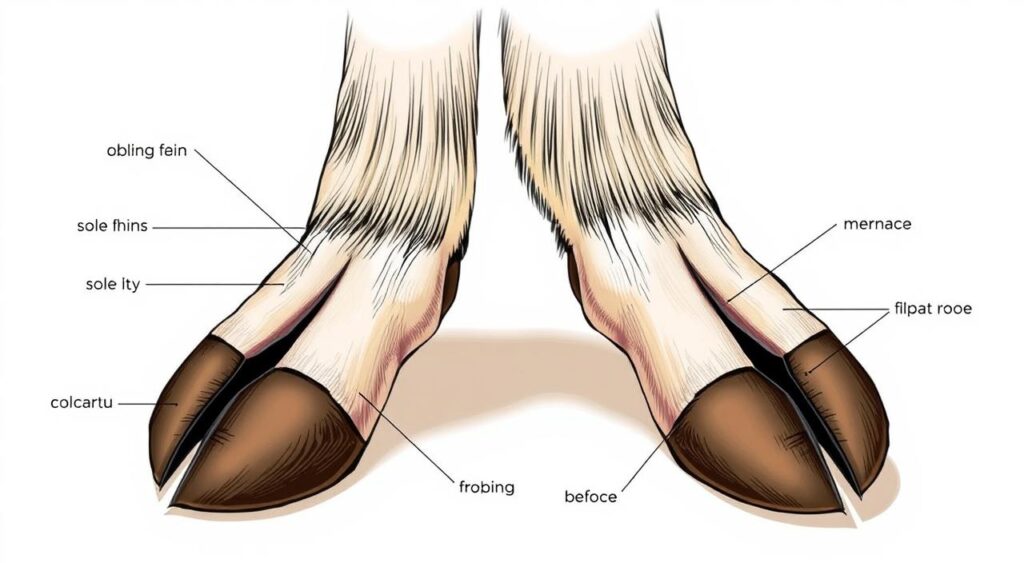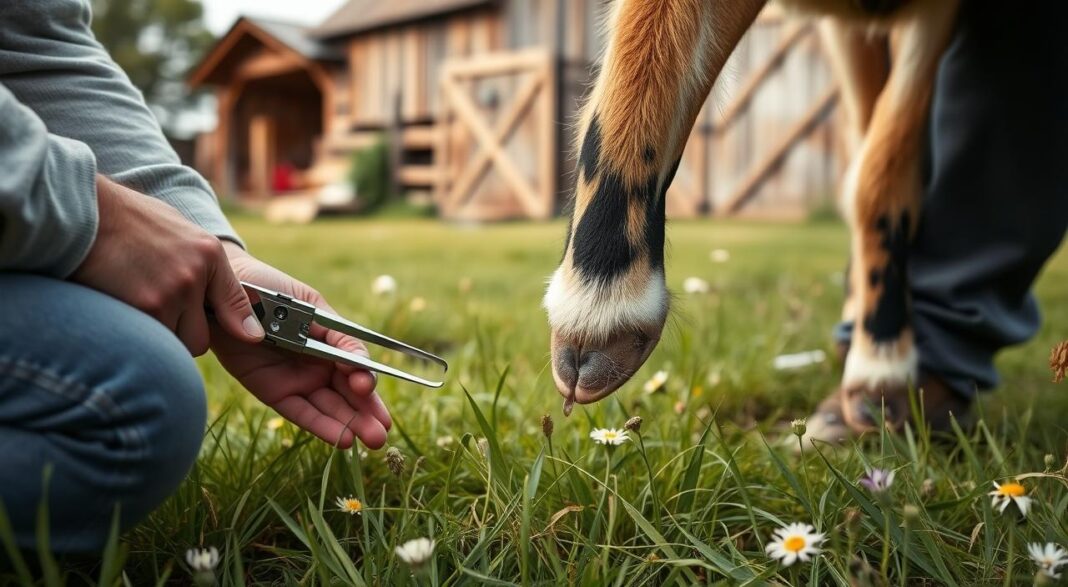Healthy hooves are crucial for your goat’s overall well-being. Goat hooves grow continuously, just like human fingernails. Regular hoof care is essential to keep your goats mobile and healthy.
Goat hoof care involves more than just trimming. It includes regular check-ups, proper nutrition, and a clean living space. Understanding these basics helps prevent common issues and keeps your goats active.
Hoof trimming frequency depends on the goat’s breed, diet, and environment. Aim to trim your goat’s hooves every 2-4 weeks. This schedule maintains proper hoof angles and prevents gait problems.
Regular trimming also helps avoid joint issues. It’s a key part of keeping your goats healthy and comfortable.
Key Points
- Goat hooves grow continuously and require regular maintenance
- Trim hooves every 2-4 weeks for optimal health
- Proper trimming angle is crucial to prevent gait issues
- Diet and living conditions affect hoof health
- Regular inspections help catch problems early
- Clean, dry environments promote healthy hooves
Understanding Goat Hoof Anatomy
Goat hoof care begins with knowing their unique foot structure. Caprine hooves are built for balance and mobility on various terrains. Their design is key to maintaining good foot health.
The cloven hoof structure
Goats have split hooves, which give them better grip and agility. Each hoof has a hard outer layer and a softer inner area. The inner part connects to blood supply and nerves.
A study of adult white goats showed complex hoof bulb tissues. These include a keratinized epidermal layer and a dermal layer with blood vessels and nerves.
- Epidermal layer: Fully keratinized, thickening the hoof bottom
- Dermal layer: Contains blood vessels and nerves
- Dermal papillae: Connect the epidermal and dermal layers
- Subcutaneous connective tissues: Provide cushioning

Dewclaws and their function
Dewclaws are small structures higher on the goat’s leg. They help with traction on steep or uneven surfaces. While not weight-bearing, dewclaws add to overall foot health and stability.
Natural hoof growth patterns
Goat hooves grow continuously, like human fingernails. In nature, regular wear keeps hoof growth in check. On farms, regular trimming is needed for proper hoof care.
Growth rates vary among goats and breeds. Diet and environment can influence how fast hooves grow.
| Hoof Structure | Measurement | Function |
|---|---|---|
| Tube spacing | 140-250 μm | Provides flexibility |
| Tube diameters | 80-110 μm | Supports weight distribution |
| Inclined angle | ~57° | Aids in shock absorption |
| Layer thickness | ~1.3 mm | Protects inner structures |
Knowing these features is vital for good caprine hoof management. It helps maintain optimal goat foot health and prevents problems.
The Importance of Regular Hoof Maintenance

Goat hoof maintenance is vital for responsible livestock care. Regular trimming prevents lameness and keeps goats healthy and active. Spring’s wet conditions make it crucial for vigilant hoof care.
Experts suggest trimming goat hooves 1-2 times yearly. Schedule trimming 45-60 days before breeding season to avoid hoof issues affecting reproduction. Neglecting hoof care can cause mobility problems and lower productivity.
Reasons why regular hoof maintenance is vital:
- Prevents foot rot, a contagious bacterial infection
- Reduces risk of lameness and hoof damage
- Maintains proper gait and comfort
- Allows early detection of potential problems
- Supports overall goat health and longevity
For healthy hooves, give each goat about 2 square meters of space. Ensure proper nutrition, especially zinc intake. Avoid overcrowding and dirty conditions.
Goats need constant movement due to their fast metabolism. Healthy hooves are crucial for their well-being. Develop a hoof care routine to make it easier for you and your goats.
Regular maintenance prevents issues and boosts goats’ health and productivity. Your efforts will pay off in happier, healthier goats.
Goat Hoof Trimming Techniques
Proper goat hoof care prevents lameness and maintains overall health. Regular trimming is crucial in small ruminant operations. It helps detect and address issues early on.
Proper tools for hoof trimming
Use sharp hoof shears, a farrier’s rasp, and a hoof pick for effective trimming. Well-maintained tools reduce hand strain and save time. Wear thick work gloves for protection when handling multiple goats.

Step-by-step trimming guide
Begin by cleaning the hoof thoroughly. Trim small amounts from the edge, keeping a proper angle. The hoof should support weight on its outer edge and heel bulb.
Align the bottom edge parallel to the coronary band. Avoid over-trimming to prevent bleeding and toe granulomas.
Frequency of trimming based on environment
Generally, trim goat hooves every 6-10 weeks. Trimming frequency depends on genetics, diet, health, and activity levels. Sanctuary environments may require more frequent attention.
Older or less active goats might need more frequent trimming. Regular inspections help determine individual needs. This prevents hoof overgrowth and maintains goat health.
In wet and warm conditions, trim every 4-6 weeks. For dry and rocky terrain, trim every 8-10 weeks. Sanctuary or limited activity environments may need trimming every 2-4.
| Environment | Trimming Frequency |
|---|---|
| Wet and warm conditions | Every 4-6 weeks |
| Dry and rocky terrain | Every 8-10 weeks |
| Sanctuary or limited activity | Every 2-4 weeks |
Recognizing Common Hoof Problems in Goats
Goat hooves can face various issues affecting health and mobility. Knowing these problems is vital for herd well-being. Let’s look at common hoof diseases and their signs.

Foot rot and foot scald are costly hoof diseases in goats. They thrive in wet, warm environments and spread quickly. Signs include limping, reluctance to walk, and grazing on knees.
Severe foot rot may show pus and a foul odor. Overgrown hooves are another common issue. They can curl inward or outward, making walking uncomfortable.
Regular inspections help catch hoof problems early. Look for these signs:
- Unusual gait or lameness
- Discoloration of the hoof
- Foul odors
- Discharge between the toes
- Swelling around the hoof area
Early detection and treatment prevent major losses for goat producers. Laminitis in goats is another serious condition needing quick attention.
| Hoof Problem | Cause | Main Symptoms | Prevention |
|---|---|---|---|
| Foot Rot | Bacteria in moist environments | Severe lameness, foul odor | Keep environment dry, regular trimming |
| Foot Scald | Fusobacterium necrophorum | Inflammation between toes | Maintain clean, dry conditions |
| Overgrown Hooves | Lack of wear or trimming | Curled hooves, altered gait | Regular hoof trimming |
| Abscesses | Injury or infection | Swelling, heat, lameness | Proper hoof care, clean environment |
Nutrition and Its Impact on Hoof Health
Good nutrition is key for healthy goat hooves. A balanced diet ensures strong hooves and overall well-being. Let’s look at the main parts of hoof nutrition.
Essential Minerals for Strong Hooves
Some minerals are vital for healthy goat hooves. Calcium and phosphorus make hooves strong. Selenium helps prevent cracked hooves.
Biotin, a B-vitamin, helps hooves grow and stay strong. A dose of 15-20 milligrams daily can improve poor hoof condition.
The Role of Zinc in Hoof Integrity
Zinc is crucial for making keratin and keeping hoof tissue healthy. Goats with weak hooves often have low zinc levels.
Look for mineral supplements with high zinc levels. Chelated zinc sources work better than zinc oxide.
Balanced Diet Recommendations
A balanced diet is key for healthy goat hooves. Goats need to eat 3-4% of their body weight daily.
Make sure they get enough protein, especially when growing or nursing. Here’s a table of basic nutrients adult goats need:
| Nutrient | Requirement (% of diet) |
|---|---|
| Protein | 12-14% |
| Total Digestible Energy (TDN) | 60-65% |
| Calcium | 0.3-0.8% |
| Phosphorus | 0.25-0.4% |
| Zinc | 40-50 ppm |
Nutrient needs may change based on the goat’s life stage. Talk to a vet or animal nutritionist about your goats’ specific needs.
Environmental Factors Affecting Goat Hoof
Your goat’s surroundings greatly impact hoof health. Understanding how different conditions affect hooves is crucial for proper care. Let’s explore key factors that influence hoof maintenance.
Moisture levels play a big role in hoof health. Wet conditions soften hooves, making them prone to infections. Dry environments can cause cracking. Ensure good drainage in pens and barns to prevent moisture buildup.
Terrain type affects natural hoof wear. Rocky areas file down hooves, while soft pastures cause faster growth. Provide varied terrain for your goats to promote natural hoof maintenance.
Climate also impacts hoof health. In rainy or humid areas like Arkansas, goats face higher risks. Hoof scald and rot thrive in temperatures between 50-70°F.
| Environmental Factor | Impact on Goat Hooves | Hoof Care Recommendation |
|---|---|---|
| Wet Conditions | Softens hooves, increases infection risk | Improve drainage, provide dry bedding |
| Rocky Terrain | Natural hoof wear | Less frequent trimming needed |
| Soft Pastures | Faster hoof growth | More frequent trimming required |
| High Humidity | Increases risk of hoof diseases | Regular inspections, preventive foot baths |
Adjust your hoof care routine to your goat’s environment. Regular checks and quick actions can prevent many hoof problems. Keep an eye on your goats’ hooves to ensure their well-being.
Preventive Measures for Optimal Hoof Care
Goat hoof care is crucial for healthy animals. Good practices can prevent common goat diseases. Let’s explore key strategies for effective hoof maintenance.
Maintaining Clean and Dry Living Conditions
Keep goat areas clean and dry to prevent bacterial growth. Use sand around water sources to reduce moisture. This simple step can greatly improve goat foot health.
Regular Hoof Inspections
Check hooves often to catch issues early. Set up a trimming schedule based on each goat’s needs. This proactive approach is key for effective hoof care.
Implementing Proper Bedding Practices
Choose bedding that supports hoof health. Ensure good drainage in pens and pastures. This helps minimize moisture exposure and reduces hoof problems.
| Preventive Measure | Benefits | Frequency |
|---|---|---|
| Clean living areas | Reduces bacterial growth | Daily |
| Hoof inspections | Early problem detection | Weekly |
| Proper bedding | Minimizes moisture exposure | As needed |
| Nutritional support | Promotes strong hooves | Daily |
These measures will improve goat foot health. They’ll also reduce the need for extensive treatments. Regular hoof care keeps goats healthy and happy.
Treating Hoof Diseases and Injuries
Goat hoof problems can cause serious health issues if ignored. Hoof rot, laminitis, and abscesses are common diseases that often lead to lameness. Quick action is crucial for treating these conditions.
Hoof rot spreads easily and may affect multiple feet. Treatment includes trimming, soaking in Epsom salt and iodine, and medication. Severe cases might take months to heal fully.
Laminitis, often caused by sudden diet changes, results in pain and lasting hoof damage. Managing it requires slow diet adjustments and weight control.
Hoof abscesses usually stem from injuries that let bacteria infect the hoof. Treatment involves cleaning the wound, using medication, and easing pain. Regular checks can help prevent these issues.
For optimal goat health, keep their environment clean and trim hooves routinely. When treating hoof diseases, separate affected goats to stop spread.
Seek a vet’s help for ongoing or severe cases. Prevention is key in goat hoof care. A balanced diet with essential minerals can greatly lower the risk of hoof problems.
| Hoof Disease | Cause | Treatment |
|---|---|---|
| Hoof Rot | Bacterial infection in moist conditions | Trimming, soaking, medication |
| Laminitis | Sudden diet changes, excessive grain | Diet adjustment, weight control |
| Hoof Abscess | Injury leading to bacterial infection | Wound cleaning, medication, pain management |
Conclusion
Proper goat hoof care is vital for healthy caprine hooves. Studies show regular maintenance greatly improves hoof conditions. After proper care, overgrown hooves decreased from 77.8% to 17.6%.
Your role in hoof maintenance is crucial. A consistent trimming schedule prevents lameness and discomfort. Hind hooves often need more attention due to dipped heels.
Regular inspections allow early problem detection. This ensures your goats stay healthy and productive. Nutrition is key for hoof health.
A balanced diet with essential minerals supports strong hooves. Clean, dry living conditions also promote optimal hoof health. By focusing on these aspects, you’re enhancing your goats’ overall well-being.




